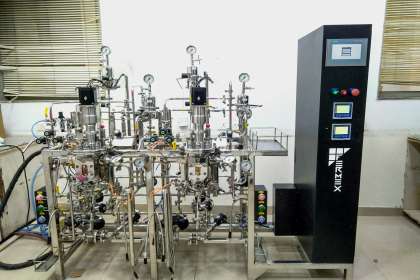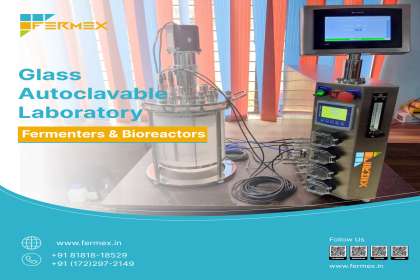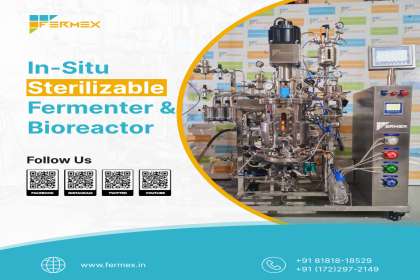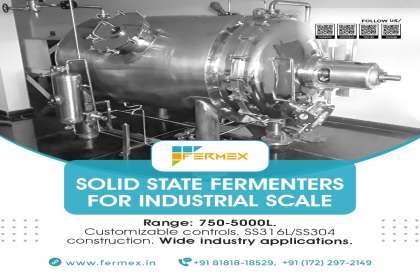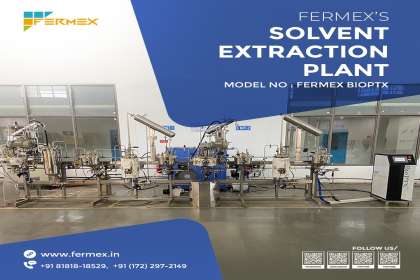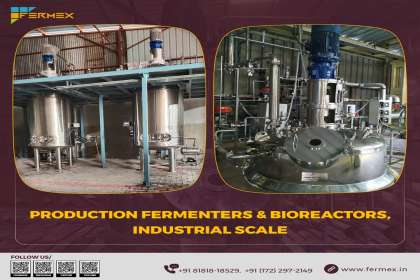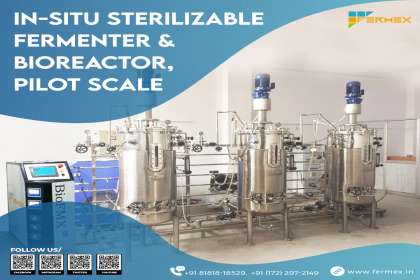
Use of Fermenter in production of Animal Feed
Fermenters play a significant role in the production of animal feed through a process known as fermentation. Fermentation involves the controlled growth of microorganisms, such as bacteria or fungi, to convert raw materials into more nutritious and easily digestible feed for animals. The use of fermenters in animal feed production offers several benefits, including improved nutritional content, enhanced digestibility, and reduced anti-nutritional factors.
Key stages involve in production of Animal feed using fermenter
The production of animal feed using a fermenter involves several key stages. These stages are carefully managed to ensure the proper growth of beneficial microorganisms and the fermentation of raw materials to produce high-quality and nutritious feed. Here are the key stages involved in the production of animal feed using a fermenter:
- Selection of Raw Materials: The first step is to select appropriate raw materials for the animal feed. These can include grains, oilseeds, fibrous materials, and other agricultural by-products. The choice of raw materials depends on the type of animals being fed and their specific nutritional requirements.
- Grinding and Pre-processing: The selected raw materials are ground or processed to create a suitable particle size. This aids in the fermentation process by increasing the surface area available for microbial activity and enzyme action.
- Mixing and Formulation: The pre-processed raw materials are mixed in specific proportions to create a balanced and nutritionally rich feed blend. Formulation is crucial to ensure that the final feed meets the dietary requirements of the target animals.
- Inoculation of Microorganisms: In this stage, the selected beneficial microorganisms (probiotics) are introduced into the mixture. These can include lactic acid bacteria, yeast, or other fermentation-promoting microorganisms. The inoculation is typically done in a fermenter under controlled conditions.
- Fermentation Process: The mixture, now containing the inoculated microorganisms, is subjected to fermentation in the fermenter. The fermenter provides the ideal conditions for the microorganisms to grow and metabolize the feed ingredients. Temperature, pH, and oxygen levels are carefully controlled to support the optimal growth of the selected microorganisms.
- Monitoring and Control: Throughout the fermentation process, the conditions inside the fermenter are continuously monitored. Any deviations from the desired parameters are promptly corrected to maintain a stable and efficient fermentation environment.
- Fermentation Duration: The fermentation process can last for several hours to days, depending on the type of feed and the desired outcomes. During this time, the microorganisms work to break down complex carbohydrates, proteins, and other components into simpler and more nutritious forms.
- Product Harvesting: Once the fermentation process is complete, the fermented feed is harvested from the fermenter. The resulting feed may be in a wet or dry form, depending on the specific fermentation process used.
- Post-Fermentation Processing: In some cases, additional post-fermentation processing may be required. This can include drying, cooling, or pelleting the fermented feed to improve its shelf life and handling characteristics.
- Quality Control: The final fermented feed undergoes quality control testing to ensure that it meets the desired nutritional specifications and is safe for animal consumption.
- Packaging and Storage: The finished fermented animal feed is packaged and stored in appropriate containers to maintain its quality and prevent contamination.
Fermex Solutions LLP manufacture fermenters that can be used for these production.
Benefits of Fermenters in the production of Animal Feed
Fermenters offer several important benefits in the production of animal feed. These benefits stem from the controlled fermentation process, which involves the growth of beneficial microorganisms to transform raw materials into a more nutritious and easily digestible feed.
Here are some of the key advantages of using fermenters in animal feed production:
- Improved Nutritional Value: Fermentation enhances the nutritional profile of animal feed by breaking down complex carbohydrates, proteins, and other components into simpler forms that are more readily absorbed by animals. This results in increased availability of essential nutrients, such as amino acids, vitamins, and minerals, leading to improved animal growth, health, and performance.
- Enhanced Digestibility: Fermented feed is more easily digestible for animals compared to non-fermented feed. The beneficial microorganisms present in the fermenter produce enzymes that help break down indigestible components, reducing the overall burden on the animal’s digestive system.
- Reduction of Anti-Nutritional Factors: Many plant-based feed ingredients contain anti-nutritional factors that hinder the absorption of nutrients in animals. Fermentation helps to degrade these anti-nutritional factors, making the feed safer and more nutritious for animal consumption.
- Gut Health and Probiotics: The fermentation process encourages the growth of beneficial microorganisms, such as lactic acid bacteria and yeast, which act as probiotics. These probiotics improve gut health by promoting a balanced gut microbiota, enhancing nutrient absorption, and inhibiting the growth of harmful pathogens.
- Decreased Pathogenic Load: Fermentation can reduce the number of harmful pathogens present in the feed. The controlled fermentation conditions create an environment that is less favorable for the survival and proliferation of pathogens, thus enhancing feed safety and reducing the risk of animal infections.
- Palatability Improvement: Fermentation can enhance the palatability and aroma of the feed, making it more appealing to animals. This can encourage animals to consume more feed, leading to better feed intake and, consequently, improved growth and productivity.
- Waste Reduction and Utilization: Fermenters can be utilized to process agricultural by-products and waste materials that may not be suitable for direct consumption by animals. By fermenting these materials, their nutritional value is improved, and they can be effectively utilized in animal feed, reducing waste and maximizing resource utilization.
- Silage Production: Fermenters are commonly used in the production of silage, a fermented feed made from green forage crops. Silage preserves forage crops, making them available for animal consumption during times when fresh forage is not abundant.
- Environmental Benefits: Fermenters promote sustainable feed production by reducing the environmental impact of livestock farming. The use of fermentation can lead to decreased nutrient excretion in animal waste, which, in turn, reduces nutrient runoff and its negative effects on water bodies.
- Customization and Flexibility: The fermentation process is adaptable, allowing feed manufacturers to tailor feed formulations to meet the specific nutritional needs of different animal species and life stages.








